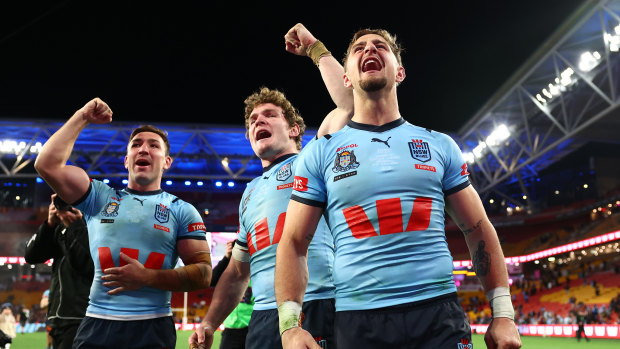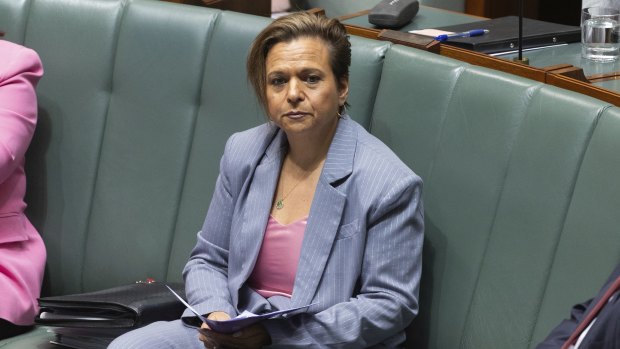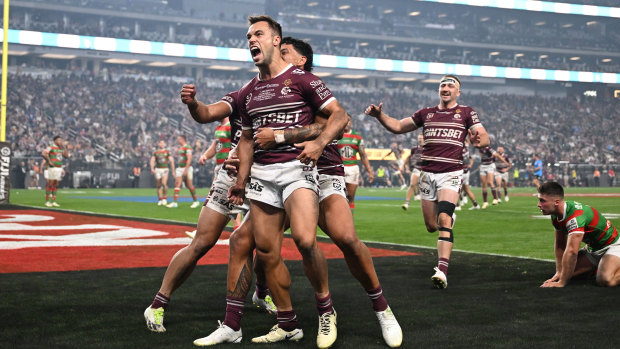- Exclusive
- Politics
- Federal
- Broadcast rights
This was published 10 months ago
NRL to test broadcast rights waters as streaming loophole appears
The National Rugby League is set to go to market for its next broadcast deal before the end of the year, seizing on new anti-siphoning laws that pave the way for it to sell streaming rights to global players such as Amazon and Netflix before a fast-tracked review of the scheme in 2026.
The NRL’s current five-year media rights deal with Foxtel, Nine Entertainment, Sky New Zealand and other international and radio partners is worth a combined $400 million a season and is not due to expire until 2027.

The State of Origin series is the NRL’s most valuable broadcast asset.Credit: Getty
But as administrators consider expanding the competition from 17 to 20 teams – including one in Papua New Guinea that the Albanese government has championed to help counter the influence of China in the Pacific – they have signalled to networks that they want to open negotiations early.
With up to two more matches a week to sell, and new timeslots and markets in Perth and on the South Island of New Zealand if such bids to join the league are successful, the code has designs on a record windfall from its next broadcast cycle.
The NRL’s desire to cash in has been boosted by the new terms of the federal government’s anti-siphoning laws, which have long been in place to ensure free coverage of events of national significance, from the Olympics and the Melbourne Cup to rugby and cricket Tests and the NRL and AFL seasons.
The Prominence and Anti-siphoning Bill, which passed both houses of parliament this month, gives free-to-air broadcasters first purchase rights to the NRL competition and men’s and women’s State of Origin series, preventing them from being offered straight to pay TV and other subscription-charging services.
But it only covers sports delivered to televisions by aerials and not on digital platforms, towards which viewers are increasingly migrating.
It means free-to-air networks may find themselves competing for online sports rights alongside tech giants such as Amazon.
Bridget Fair, chief executive of Free TV Australia, the lobby group for Nine, Seven Network and Network Ten, said she was surprised at the government’s position on streaming “because it’s a Labor policy and it should be about protecting every Australian”. Nine is the owner of this masthead.
“It’s certainly open to them [the NRL] to sell all the streaming rights to someone other than a free-to-air broadcaster,” Fair said.
‘It’s a big reduction in the scope of the anti-siphoning rules.’
Free TV Australia chief executive Bridget Fair
“It doesn’t mean they’ll do that, but it certainly opens a door that wasn’t previously open. It’s a big reduction in the scope of the anti-siphoning rules.”
Nearly a quarter of the national audience of 3.65 million that tuned in for the third match of the State of Origin series on Wednesday night watched it via Nine’s free app 9Now, making it the second-highest streamed live sports event in Australia behind the Matildas’ World Cup semi-final against England last year, viewed by 957,000 people on 7Plus.
The NRL is in the box seat to take advantage of the regulatory loophole for streaming, which could potentially be closed by a review of the new laws originally slated for 2029 but brought forward by three years because of rapidly evolving viewing habits.
The timing may allow it to get one up on the rival Australian Football League, whose $640 million-a-year deal with Seven West Media and Foxtel doesn’t kick off until 2025 and runs until 2031. Another potential beneficiary is Foxtel-owned streaming provider Kayo Sports, which has had its path cleared to trump free-to-air operators on digital rights.

Communications Minister Michelle Rowland says the anti-siphoning bill strikes the right balance.Credit: Alex Ellinghausen
Communications Minister Michelle Rowland said the government’s law changes regulated global streaming companies for the first time.
“The government’s legislation ensures free-to-air broadcast TV gets the first opportunity to acquire rights to major sporting events, while allowing a range of services, including free TV broadcasters, to bid for the digital (or streaming) rights,” she said.
“This strikes the right balance between ensuring a safety net so all Australians can watch major sporting events for free, and the ability of sporting organisations to ensure a commercial return to support the ongoing development of sport in Australia.”
Rowland added: “It’s important to note, both broadcast and streaming rights to the NRL, AFL, Olympics, international cricket and Australian Open are held by free-to-air television for years into the future.”
The NRL declined to comment.
The anti-siphoning scheme has been updated as a federal government review of gambling advertising that could dent sporting codes’ returns from broadcasters has stalled.
It also comes as the NRL has been in negotiations with the Labor government about adding a team later this decade in PNG under the banner of sports diplomacy. It would be backed by up to $600 million in public funding over 10 years for the venture itself and towards development.
There have been concerns raised about the long-term sustainability of a PNG team, as well as over security, the ability to convince players to live in the capital, Port Moresby, and the limited value for broadcasters. But while it must convince sceptical clubs of its merits, Australian Rugby League Commission chairman Peter V’landys said in May the NRL and government were “aligned” in their positions.
The NRL is due to finalise its expansion blueprint by the end of the season in October before approaching broadcasters.
It will do so as Amazon Prime Video has entered the rights landscape in Australia, paying a reported $80 million a year to exclusively show all global cricket tournaments including World Cups and the Test World Championship between 2024 and 2027.
Colin Smith, the principal of sports advisory firm Global Media and Sports, believes the NRL could hold some appeal to overseas streaming giants.
“With the NRL they could say, ‘we want those NRL rights into England as well’ – that could be of interest. And is there a play with the Las Vegas strategy?” he said.
The NRL has embarked on an ambitious, five-year plan to launch its season in the United States entertainment mecca, but the first edition in March produced underwhelming American TV ratings, with an average audience of 61,000 for the highest rating of the two games.

The NRL kicked off its season in Las Vegas as part of a five-year strategy to reach new markets.Credit: NRL Photos
Smith said sports broadcasters around the world were reaching a tipping point where they would only be willing to pay premiums for must-haves.
Jon Marquard, who runs TV rights consultancy Janez Media, also forecasts headwinds and does not see the anti-siphoning loophole changing the face of sports rights dramatically.
He said the government’s stance on streaming would give the NRL more options in packaging games, but anticipated that the rights would be valued more heavily by the incumbents.
“NRL is a fantastic sport in Australia and New Zealand and it’s got some currency in the UK,” Marquard said. “But it doesn’t have that wide-ranging global appeal as other sports do … so it may not necessarily have the appeal to the tech giants that other sports might have.”
Cut through the noise of federal politics with news, views and expert analysis. Subscribers can sign up to our weekly Inside Politics newsletter.